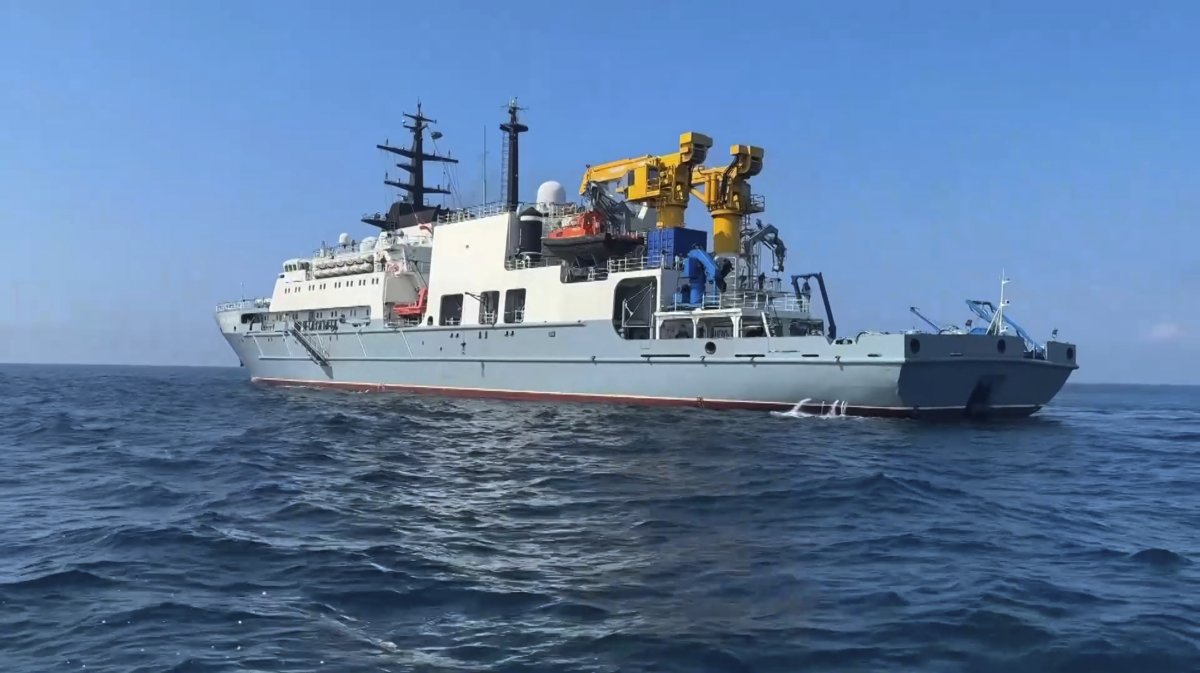-
US Woman Responds as Video Labeling Europe ‘Not First World’ Sparks Debate - 22 mins ago
-
BMW’s Neue Klasse SUV Sets New Benchmark in Sustainability - 25 mins ago
-
High-stakes clandestine poker world led to Hollywood Hills murder - 31 mins ago
-
More Home Run Derbies? MLB Teams Are Expanding on the All-Star Concept - 32 mins ago
-
Ultra-thin sound blocker cuts traffic noise dramatically - 34 mins ago
-
Trump’s envoy meets Putin ahead of Russia-Ukraine peace deadline - 53 mins ago
-
Orbán and the Great Russia-Gate Hoax - about 1 hour ago
-
Tourist Stuck at Top of Stairs With Suitcase—Plan To Get Down Goes Viral - about 1 hour ago
-
Jerry Jones Shares He Hasn’t Spoken With Micah Parsons Since Trade Request - about 1 hour ago
-
HUF 100 Billion Bought in One Week Amid Retail Investor Frenzy - 2 hours ago
Russia and China’s Navies Hold Submarine Rescue Drills
The Russian and Chinese navies have conducted simulated submarine rescue operations as part of a bilateral war game, after which they commenced a joint patrol in the Western Pacific.
Newsweek has emailed the Russian and Chinese defense ministries for further comment.
Why It Matters
Russia and China have formed a quasi-alliance to challenge their mutual rival, the United States, and are pushing for closer military cooperation. According to the Center for Strategic and International Studies’ ChinaPower project, more than half of the 113 military exercises involving Moscow and Beijing since their first in 2003 have occurred in the past six years.
The submarine rescue drill comes as both Russia and China bolster their underwater forces. Russia has modernized a Far Eastern naval base to homeport nuclear-powered submarines, while China—operator of the world’s largest navy by hull count—is expanding its fleet through the integration of new technologies and the growth of its shipbuilding capacity.
What To Know
Citing the Russian Pacific Fleet, the Tass news agency reported on Tuesday that Russia and China each deployed a naval rescue vessel, an underwater rescue vehicle, and a diesel-electric submarine to simulate rescuing the crew of a damaged submarine on the sea floor.
Rescue vessels of the RuNAVY and the PLAN practiced the task of rescuing the crew of a conditionally damaged submarine lying on the ground.
Type 927 submarine support ship “Xihu” («LR-7»)➡️🇷🇺Sub.
Pr. 21300 rescue vessel “Igor Belousov”(DSRV«АС-40»)➡️🇨🇳Sub.https://t.co/LxemLQEoRI pic.twitter.com/My2y5B9ZC1— Massimo Frantarelli (@MrFrantarelli) August 5, 2025
According to the report, both participating units took turns conducting the rescue simulation in the designated area of the Peter the Great Gulf, near Vladivostok in Russia’s Far East.
The Chinese military’s media outlet, the People’s Liberation Army Daily, revealed that after locating the Russian submarine in mock distress, CNS Xihu, a Chinese rescue ship, deployed its submersible to dock with the submarine in a simulated rescue.
Wang Yunfei, a Chinese military expert, told China’s Global Times that the participation of submarines in the exercise shows the deepening military ties between China and Russia, as much submarine data—including noise characteristics—is considered classified.
The drill was part of the larger Joint Sea 2025 exercise, held near Vladivostok from Friday to Tuesday, according to statements from both sides. It aimed to improve joint search-and-rescue operations, rehearse anti-submarine warfare tactics, and operate air defense systems.
Russian Defense Ministry Press Service photo via AP
Following the conclusion of the naval war game, the Russian and Chinese navies proceeded with a maritime joint patrol in the Western Pacific on Wednesday, China Central Television reported. However, the exact patrol area has yet to be officially announced by either side.
What People Are Saying
Senior Colonel Zhang Xiaogang, spokesperson for China’s Defense Ministry, said at a press conference on July 30: “[Exercise Joint Sea 2025] is an arrangement within the annual cooperation plan between the Chinese and Russian militaries. It is not targeted at any third party, nor is it related to the current international and regional situation.”
The Center for Strategic and International Studies’ ChinaPower project commented in a report on July 17: “Unlike military aid and arms sales, which have waxed and waned over the decades, joint exercises are a newer and thriving element of China-Russia military ties and a driver behind the strengthening of China-Russia relations in recent years.”
What Happens Next
It remains to be seen whether the Russian and Chinese navies will stage a show of force during their joint patrol. This comes as the U.S., along with its allies, has deployed four warships capable of operating F-35 stealth jets in the Western Pacific for an exercise.

Russian Defense Ministry Press Service photo via AP
Source link






























